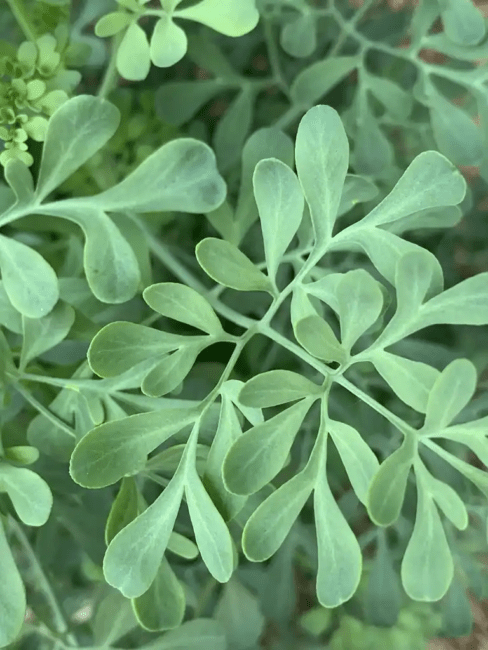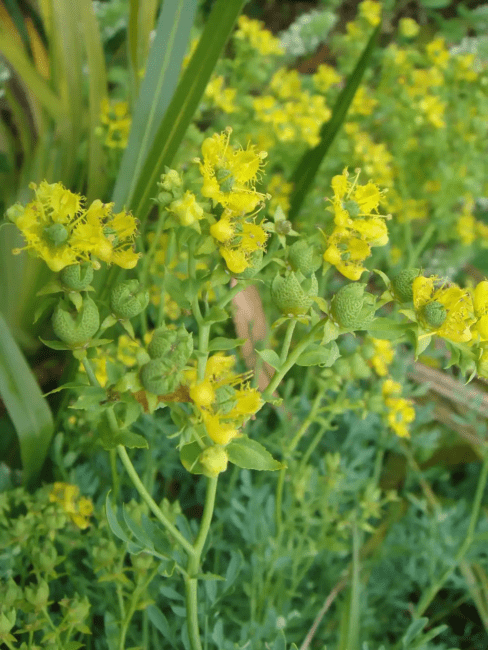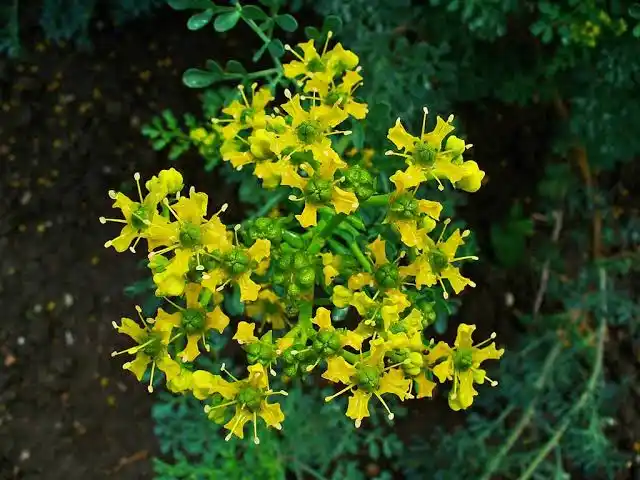Ruta, commonly known as Rue, is a perennial herb native to Southern Europe. This aromatic plant is adorned with bluish-green, feathery leaves that exude a pungent fragrance when crushed. Rue’s botanical name, Ruta graveolens, underscores its strong scent.
With a rich history dating back to ancient times, Rue has found various applications in medicine, culinary traditions, and folklore. Its bitter taste has earned it a place in the culinary world, where it has been used sparingly to add depth and flavor to dishes.
However, caution is advised, as excessive consumption can lead to toxicity due to its naturally occurring compounds.
Rue has been employed for its potential healing properties. It was once believed to have protective qualities and was worn as an amulet to ward off evil spirits. Rue was used to treat ailments like digestive issues, menstrual discomfort, and respiratory problems.
Despite its historical significance, Rue should be handled with care, as its essential oil can be irritating to the skin, and ingestion should be limited due to potential toxicity.
Today, Rue’s uses have become less common, but its enduring presence in gardens serves as a reminder of its multifaceted past.
The Botanical Description of Ruta
Ruta, commonly known as rue, is an aromatic herb with a rich history and a distinctive botanical profile. Let’s discuss the botanical description of this remarkable plant:
1. Genus and Species: Ruta belongs to the genus Ruta and encompasses various species, with Ruta graveolens being the most well-known for its medicinal and culinary uses.
2. Growth Habit: Ruta is a perennial herb characterized by a bushy growth habit. It can reach a height of 2 to 3 feet (60 to 90 cm). The plant is known for its beautiful bluish-green foliage.
3. Leaves: The leaves of Ruta are alternate, pinnate, and deeply divided. They are composed of multiple leaflets with a grayish-green color. The leaves have a strong, distinctive scent when crushed.
4. Flowers: Rue produces small, bright yellow, and star-shaped flowers. These flowers have a delightful fragrance and are arranged in clusters at the ends of the branches.
5. Fruits: The fruits of Ruta are small, round capsules that contain numerous tiny seeds. The seeds are generally dark brown or black in color.
6. Root System: Ruta typically has a fibrous root system that spreads rather than delving deeply into the soil.
7. Aromatic Qualities: One of the most remarkable features of Ruta is its strong and pungent aroma. The leaves and other parts of the plant release a distinctive scent when touched or crushed.
8. Medicinal Properties: The strong aroma and the presence of bioactive compounds in Ruta contribute to its traditional use in herbal medicine. It is known for its digestive, anti-inflammatory, and antimicrobial properties.
The Geographic Distribution of Ruta
Ruta has a diverse geographic distribution, thriving in various regions around the world. Here, we’ll explore the plant’s presence in different parts of the globe:
1. Native Regions: Ruta is believed to have originated in the Mediterranean region, where it has been cultivated and used for centuries. The plant has a deep-rooted history in the culinary and medicinal traditions of this area.
2. Mediterranean Countries: Ruta is native to countries bordering the Mediterranean Sea, including Spain, Italy, Greece, and southern France. It has been an integral part of Mediterranean cuisine and herbal remedies.
3. Europe: Beyond the Mediterranean region, Ruta is also found in other parts of Europe, including central and eastern European countries. It has adapted to diverse climates and can be found in both wild and cultivated forms.
4. North America: Ruta was introduced to North America by early European settlers, and it has naturalized in some regions. It can be found in parts of the United States and Canada, especially in gardens and herb collections.
5. Asia: Ruta has made its way into various Asian countries, where it is sometimes grown as a culinary herb or used in traditional medicine.
6. Cultivation Worldwide: Thanks to its adaptability and hardy nature, Ruta is cultivated and grown in gardens and herb farms worldwide. This allows for the easy availability of fresh rue leaves for culinary and medicinal purposes.
7. Ornamental Use: In addition to its culinary and medicinal value, Ruta is often grown as an ornamental plant in gardens due to its attractive foliage and aromatic properties.
8. Environmental Adaptability: Ruta demonstrates adaptability to a wide range of climates, from hot and arid regions to temperate zones. This adaptability has contributed to its global presence.
The Chemical Composition of Ruta
The chemical composition of Ruta is responsible for its unique aroma and its various medicinal properties. Let’s outline the key compounds found in this remarkable plant:
1. Essential Oils: Ruta contains essential oils, with compounds such as 2-undecanone, limonene, and camphor contributing to its characteristic fragrance. These oils are responsible for the strong aroma of rue leaves.
2. Rutin: Rutin is a flavonoid that is commonly found in Ruta. It is known for its antioxidant properties and has been associated with various health benefits.
3. Alkaloids: Ruta is known to contain alkaloids, including rutacridone and skimmianine. These compounds are associated with the plant’s bitter taste and potential medicinal effects.
4. Coumarins: Some species of Ruta contain coumarins, such as rutamarin and umbelliferone. Coumarins have various biological activities and are under investigation for their potential health benefits.
5. Flavonoids: In addition to rutin, Ruta also contains other flavonoids like quercetin and kaempferol, which are known for their antioxidant and anti-inflammatory properties.
6. Tannins: Tannins are polyphenolic compounds found in Ruta, contributing to its astringent properties. They are often associated with traditional medicinal uses.
7. Organic Acids: Ruta contains organic acids like citric acid and malic acid. These acids are responsible for the plant’s slightly sour taste.
8. Phytochemical Variability: It’s important to note that the chemical composition of Ruta can vary among different species and varieties, which may impact its specific medicinal properties.
Ruta’s chemical composition makes it a plant of interest in both culinary and traditional medicine, and ongoing research continues to uncover its potential health benefits and applications.
Read Also: The Pervasive Pests: Whiteflies – Nuisance or Nightmare?
The Medicinal Health Benefits Of Ruta (Rue)

Ruta, or rue, is a versatile herb with a long history of traditional use in herbal medicine. It offers a wide range of medicinal health benefits, making it a valuable addition to your herbal remedies. Let’s explore 17 of its remarkable health benefits:
1. Digestive Aid: Rue has been used to alleviate digestive discomfort, including indigestion and bloating.
2. Anti-Inflammatory: Its anti-inflammatory properties may help reduce inflammation in various conditions.
3. Menstrual Support: Rue has been used to relieve menstrual cramps and regulate menstrual cycles.
4. Anti-Spasmodic: It can help alleviate muscle spasms and cramps.
5. Antioxidant: The presence of antioxidants in rue may protect cells from oxidative stress.
6. Respiratory Health: Rue has been used to support respiratory health and ease breathing difficulties.
7. Immune Boost: It may help strengthen the immune system, making the body more resilient against infections.
8. Skin Care: Rue’s antimicrobial properties make it useful for topical skin applications.
9. Pain Relief: It may offer relief from mild pain and discomfort.
10. Eye Health: Rue is traditionally used for eye health, especially to alleviate eye strain.
11. Fever Reduction: It has been employed to reduce fever in some traditional remedies.
12. Heart Health: Rue may have a positive impact on heart health and circulation.
13. Anti-Anxiety: It may help reduce anxiety and promote a sense of calm.
14. Antiseptic: Rue can be used as a natural antiseptic for minor wounds and cuts.
15. Anti-Helminthic: It has been traditionally used to combat parasitic infections.
16. Anti-Arthritic: Rue’s anti-inflammatory properties may benefit individuals with arthritis.
17. Aphrodisiac: Some traditional practices associate rue with aphrodisiac effects.
Methods of Usage to Achieve the Provided Health Benefits Of Ruta (Rue)
To incorporate the medicinal health benefits of rue, it’s essential to know how to use it effectively. Here are various methods of usage:
1. Herbal Teas: Brewing rue leaves into herbal teas is a common method. This is particularly beneficial for digestive and respiratory support.
2. Tinctures: Rue tinctures are concentrated extracts that can be taken in small, controlled doses.
3. Poultices: Creating a poultice with rue can be applied topically to the skin to address skin issues.
4. Aromatherapy: Rue essential oil can be used in aromatherapy to promote relaxation and reduce anxiety.
5. Culinary Use: In some cultures, rue is used as a culinary herb, adding a unique flavor to dishes.
6. Infused Oils: Preparing infused oils with rue allows for external applications on the skin.
7. Inhalation: Inhaling rue-infused steam can provide respiratory benefits.
8. Capsules: Rue supplements in capsule form offer precise dosing for certain health goals.
9. Ointments: Rue ointments can be used to address skin issues or minor wounds.
10. Baths: Adding rue-infused water to baths may promote relaxation and relieve muscle tension.
Side Effects Of Using Ruta Medicinal Plant
While rue offers numerous health benefits, it’s important to be aware of potential side effects and precautions:
1. Skin Sensitivity: Topical application of rue can cause skin sensitivity or irritation in some individuals.
2. Photosensitivity: Rue may make the skin more sensitive to sunlight, potentially leading to sunburn.
3. Oral Ingestion: Ingesting rue orally can be toxic in large quantities and should be done with caution.
4. Pregnancy and Lactation: Pregnant and lactating individuals should avoid rue due to potential complications.
5. Allergies: Some people may be allergic to rue or experience adverse reactions.
6. Interaction with Medications: Rue may interact with certain medications; consult a healthcare professional if you’re taking any prescription drugs.
7. Internal Use Precautions: Internal use of rue should be done under the guidance of a qualified herbalist or healthcare provider.
8. Children and Pets: Keep rue products out of reach of children and pets due to potential toxicity.
Read Also: Certification and Market of Organic Foods, Benefits of Certification of Organic Products
The Scientific Research and Studies of Ruta (Rue)

Scientific research and studies have explored the various aspects of rue (Ruta) and its potential health benefits. Here, we’ll highlight some of the noteworthy findings from these studies:
1. Antioxidant Properties: Scientific investigations have highlighted the antioxidant properties of rue. Antioxidants are essential for combating oxidative stress and free radical damage in the body, which can contribute to various chronic diseases.
2. Anti-Inflammatory Effects: Studies have shown that rue possesses anti-inflammatory properties. This suggests its potential in reducing inflammation, a common factor in many health conditions.
3. Digestive Benefits: Research has delved into rue’s use as a digestive aid, demonstrating its ability to alleviate symptoms of indigestion and bloating.
4. Menstrual Health: Some studies have explored rue’s effects on menstrual health. It has been suggested that rue may help regulate menstrual cycles and alleviate menstrual cramps.
5. Antispasmodic Effects: Rue’s antispasmodic properties have been studied, highlighting its potential to ease muscle spasms and cramps.
6. Respiratory Support: Research indicates that rue can be beneficial for respiratory health. It may help ease breathing difficulties and support the respiratory system.
7. Immunomodulatory Action: Studies have suggested that rue has an immunomodulatory effect, potentially strengthening the immune system’s response to infections.
8. Pain Management: Research has investigated rue’s potential for pain relief. It may offer relief from mild pain and discomfort.
9. Ocular Benefits: Some studies have explored rue’s traditional use for eye health, particularly in alleviating eye strain.
10. Fever Reduction: Rue has been studied for its ability to reduce fever in some traditional remedies.
11. Heart Health: Research has examined rue’s impact on heart health and circulation, potentially offering benefits in this regard.
12. Anxiolytic Properties: Studies have explored rue’s potential anxiolytic (anxiety-reducing) effects, which may promote relaxation and calm.
13. Antiseptic Application: Rue’s antimicrobial properties have been the subject of research for their use in antiseptic applications on minor wounds and cuts.
14. Anthelmintic Action: Scientific investigations have explored rue’s potential as an anthelmintic, which means it may help combat parasitic infections.
15. Anti-Arthritic Potential: Some studies have looked into rue’s anti-inflammatory properties in the context of arthritis, suggesting it may be beneficial for individuals with arthritis.
16. Aphrodisiac Claims: The scientific community has examined the traditional association of rue with aphrodisiac effects. However, more research is needed to validate these claims.
Safety Precautions and Recommendations In Using Ruta (Rue) Medicinal Plant
While rue offers various health benefits, it’s crucial to use it safely and responsibly. Here are important safety precautions and recommendations:
1. Skin Sensitivity: Rue can cause skin sensitivity or irritation when applied topically. Perform a patch test before applying it to a larger area of skin.
2. Photosensitivity: Rue may increase skin sensitivity to sunlight, potentially leading to sunburn. Avoid sun exposure after using rue topically.
3. Oral Use Caution: Ingesting rue orally can be toxic in large quantities. Do not consume it in excessive amounts.
4. Pregnancy and Lactation: Rue should be avoided during pregnancy and breastfeeding, as it may cause complications.
5. Allergies: Some individuals may be allergic to rue. If you have known allergies, exercise caution.
6. Medication Interaction: Rue may interact with certain medications. Consult a healthcare professional if you are taking prescription drugs.
7. Consult an Herbalist: Internal use of rue should be done under the guidance of a qualified herbalist or healthcare provider.
8. Keep Out of Reach: Ensure that rue products are stored out of reach of children and pets due to potential toxicity.
FAQs About Ruta (Rue) Medicinal Plant
Let’s address common questions and concerns about rue:
1. Is rue safe for topical application?
Rue can be applied topically but may cause skin sensitivity. Perform a patch test before widespread use.
2. Can rue be used during pregnancy?
No, rue is not recommended during pregnancy as it may lead to complications.
3. What precautions should be taken when using rue for its health benefits?
Exercise caution with rue due to potential toxicity and interactions with medications. Consult a healthcare professional or herbalist.
4. Are there any known allergies associated with rue?
Some individuals may be allergic to rue, so be vigilant when using it.
5. Can rue be used for children or pets?
Rue products should be kept out of reach of children and pets due to potential toxicity.
6. Can rue be consumed as a culinary herb?
While rue has culinary uses in some cultures, it should be used sparingly due to its potency.
7. Does rue have any aphrodisiac effects?
Rue has been traditionally associated with aphrodisiac effects, but more research is needed to confirm these claims.
8. Can rue help with respiratory issues?
Rue’s potential respiratory benefits may include easing breathing difficulties.
9. What is the typical dosage for rue supplements?
Dosages for rue supplements should be determined by a healthcare professional or herbalist.
10. Is rue effective for digestive discomfort?
Rue has been used traditionally to alleviate digestive issues such as indigestion and bloating.
11. Can rue reduce inflammation?
Studies suggest that rue possesses anti-inflammatory properties, which may help reduce inflammation in various conditions.
12. How does rue impact the immune system?
Rue’s immunomodulatory properties may help strengthen the immune system’s response to infections.
13. Can rue be used for pain relief?
Rue may offer relief from mild pain and discomfort.
14. What are the potential side effects of topical rue application?
Skin sensitivity and irritation are possible side effects of topical rue use.
15. Does rue have a role in eye health?
Rue has been traditionally used for eye health, particularly to alleviate eye strain.
16. What are the contraindications for rue?
Rue should be avoided during pregnancy and lactation, and its oral use should be approached with caution.
Remember that individual responses to rue can vary, so it’s essential to use it responsibly, following safety guidelines and consulting experts when needed.
Read Also: Everything You Need to Know About Yarrow

